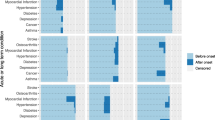Abstract
The current availability of large volumes of health care data makes it a promising data source to new views on disease interaction. Most of the times, patients have multiple diseases instead of a single one (also known as multimorbidity), but the small size of most clinical research data makes it hard to impossible to investigate this issue. In this paper, we propose a latent-based approach to expand patient evolution in temporal electronic health records, which can be uninformative due to its very general events. We introduce the notion of clusters of hidden states allowing for an expanded understanding of the multiple dynamics that underlie events in such data. Clusters are defined as part of hidden Markov models learned from such data, where the number of hidden states is not known beforehand. We evaluate the proposed approach based on a large dataset from Dutch practices of patients that had events on comorbidities related to atherosclerosis. The discovered clusters are further correlated to medical-oriented outcomes in order to show the usefulness of the proposed method.
Access this chapter
Tax calculation will be finalised at checkout
Purchases are for personal use only
Similar content being viewed by others
References
NIVEL Primary Care Database. https://www.nivel.nl/en/dossier/nivel-primary-care-database. Accessed 30 Apr 2018
Barnett, K., Mercer, S., Norbury, M., Watt, G., Wyke, S., Guthrie, B.: Epidemiology of multimorbidity and implications for health care, research, and medical education: a cross-sectional study. Lancet 380, 37–43 (2012). https://doi.org/10.1016/S0140-6736(12)60240-2
Côté, M.J., Stein, W.E.: A stochastic model for a visit to the doctors office. Math. Comput. Model. 45(3), 309–323 (2007). https://doi.org/10.1016/j.mcm.2006.03.022
Gunning, D.: Explainable Artificial Intelligence (XAI) (2016). http://www.darpa.mil/program/explainable-artificial-intelligence
Hammerschmidt, C.A., Verwer, S., Lin, Q., State, R.: Interpreting finite automata for sequential data. In: Interpretable Machine Learning for Complex Systems: NIPS 2016 Workshop Proceedings (2016)
Huang, Z., Dong, W., Wang, F., Duan, H.: Medical inpatient journey modeling and clustering: a Bayesian hidden Markov model based approach. In: AMIA Annual Symposium Proceedings, pp. 649– 658 (2015)
Huang, Z., Dong, W., Bath, P., Ji, L., Duan, H.: On mining latent treatment patterns from electronic medical records. Data Min. Knowl. Discov. 29(4), 914–949 (2015). https://doi.org/10.1007/s10618-014-0381-y
Hyvärinen, M., et al.: The impact of diabetes on coronary heart disease differs from that on ischaemic stroke with regard to the gender. Cardiovasc. Diabetol. 8(1), 17 (2009). https://doi.org/10.1186/1475-2840-8-17
Lappenschaar, M., Hommersom, A., Lucas, P.J., Lagro, J., Visscher, S.: Multilevel Bayesian networks for the analysis of hierarchical health care data. Artif. Intell. Med. 57(3), 171–183 (2013). https://doi.org/10.1016/j.artmed.2012.12.007
Lappenschaar, M., et al.: Multilevel temporal Bayesian networks can model longitudinal change in multimorbidity. J. Clin. Epidemiol. 66(12), 1405–1416 (2013). https://doi.org/10.1016/j.jclinepi.2013.06.018
Liu, S., Wang, X., Liu, M., Zhu, J.: Towards better analysis of machine learning models: a visual analytics perspective. Vis. Inform. 1(1), 48–56 (2017). https://doi.org/10.1016/j.visinf.2017.01.006
Marshall, A., Vasilakis, C., El-Darzi, E.: Length of stay-based patient flow models: recent developments and future directions. Health Care Manag. Sci. 8(3), 213–220 (2005). https://doi.org/10.1007/s10729-005-2012-z
Mytton, O.T., et al.: Association between intake of less-healthy foods defined by the United Kingdom’s nutrient profile model and cardiovascular disease: a population-based cohort study. PLOS Med. 15(1), 1–17 (2018). https://doi.org/10.1371/journal.pmed.1002484
Najjar, A., Reinharz, D., Girouard, C., Gagn, C.: A two-step approach for mining patient treatment pathways in administrative healthcare databases. Artif. Intell. Med. 87, 34–48 (2018). https://doi.org/10.1016/j.artmed.2018.03.004
O’Donovan, G., Lee, I., Hamer, M., Stamatakis, E.: Association of “weekend warrior” and other leisure time physical activity patterns with risks for all-cause, cardiovascular disease, and cancer mortality. JAMA Internal Med. 177(3), 335–342 (2017). https://doi.org/10.1001/jamainternmed.2016.8014
Prados-Torres, A., et al.: Multimorbidity patterns in primary care: interactions among chronic diseases using factor analysis. PLOS ONE 7(2), 1–12 (2012). https://doi.org/10.1371/journal.pone.0032190
Rabiner, L.R.: A tutorial on hidden Markov models and selected applications in speech recognition. Proc. IEEE 72, 257–286 (1989)
Rajkomar, A., et al.: Scalable and accurate deep learning with electronic health records. NPJ Digit. Med. 1(1), 18 (2018). https://doi.org/10.1038/s41746-018-0029-1
Sinnige, J., Korevaar, J.C., Westert, G.P., Spreeuwenberg, P., Schellevis, F.G., Braspenning, J.C.: Multimorbidity patterns in a primary care population aged 55 years and over. Family Pract. 32(5), 505–513 (2015)
Stamatakis, E., de Rezende, L.F.M., Rey-López, J.P.: Sedentary behaviour and cardiovascular disease. In: Leitzmann, M., Jochem, C., Schmid, D. (eds.) Sedentary Behaviour Epidemiology, pp. 215–243. Springer, Cham (2018). https://doi.org/10.1007/978-3-319-61552-3_9
Wijkstra, J., et al.: Treatment of unipolar psychotic depression: a randomized, double-blind study comparing imipramine, venlafaxine, and venlafaxine plus quetiapine. A. Psych. Scandinavica 121(3), 190–200 (2009)
Zhang, Y., Lin, Q., Wang, J., Verwer, S.: Car-following behavior model learning using timed automata. IFAC-PapersOnLine 50(1), 2353–2358 (2017). 20th IFAC World Congress. https://doi.org/10.1016/j.ifacol.2017.08.423
Acknowledgments
This work has been partially funded by NWO (Netherlands Organisation for Scientific Research), project Careful (62001863), by FAPEMIG, and by NORTE 2020 (project NanoSTIMA). Project “NORTE-01-0145-FEDER-000016” (NanoSTIMA) is financed by the North Portugal Regional Operational Programme (NORTE 2020), under the PORTUGAL 2020 Partnership Agreement, and through the European Regional Development Fund (ERDF).
Author information
Authors and Affiliations
Corresponding author
Editor information
Editors and Affiliations
Rights and permissions
Copyright information
© 2018 Springer Nature Switzerland AG
About this paper
Cite this paper
Bueno, M.L.P., Hommersom, A., Lucas, P.J.F., Lobo, M., Rodrigues, P.P. (2018). Modeling the Dynamics of Multiple Disease Occurrence by Latent States. In: Ciucci, D., Pasi, G., Vantaggi, B. (eds) Scalable Uncertainty Management. SUM 2018. Lecture Notes in Computer Science(), vol 11142. Springer, Cham. https://doi.org/10.1007/978-3-030-00461-3_7
Download citation
DOI: https://doi.org/10.1007/978-3-030-00461-3_7
Published:
Publisher Name: Springer, Cham
Print ISBN: 978-3-030-00460-6
Online ISBN: 978-3-030-00461-3
eBook Packages: Computer ScienceComputer Science (R0)




